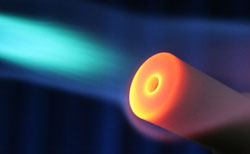Greenwich University researchers have won a SPARK award to work with Oxfordshire-based Oxsensis on the development of sensors that can simultaneously measure pressure and temperature at more than 1,000C.
Prof Chris Bailey, who leads the Computational Mechanics and Reliability Group in the School of Computer and Mathematical Sciences at the university, will use computer modelling techniques to predict how the sensors and their components would operate under different conditions of fluid flow, temperature and vibration.
The research will help Oxsensis with the design, assembly and installation of the sensors, which operate deep inside combustion engines.
Prof Bailey said: 'The aerospace and car manufacturing industries are demanding improved sensors because next-generation engines are getting much hotter. At the moment, no sensor can work reliably above 800 degrees.'
The two partners will start working together this month.
Oxsensis, which was formed in 2003 as a spin-out from Rutherford Appleton Laboratory, is developing sensor technology based on the micromachining of super-resistant materials such as single-crystal sapphire (melting point >2,000C) together with innovative fibre-optic interrogation techniques that give high sensitivity and immunity from electro-magnetic interference effects common in turbo-machinery such as gas turbines.

The SPARK awards, which started in 2002, are given to higher education institutions that help small and medium businesses tackle a problem of direct relevance to them. They also aim to encourage longer-term relationships between educational and business organisations.
The SPARK awards are organised by the Integrated Products Manufacturing Transfer Network, one of the Knowledge Transfer Networks of the Technology Strategy Board, jointly with the Innovative Electronics Manufacturing Research Centre (leMRC) of the Engineering and Physical Sciences Research Council.




Poll: Should the UK’s railways be renationalised?
Rail passenger numbers declined from 1.27 million in 1946 to 735,000 in 1994 a fall of 42% over 49 years. In 2019 the last pre-Covid year the number...